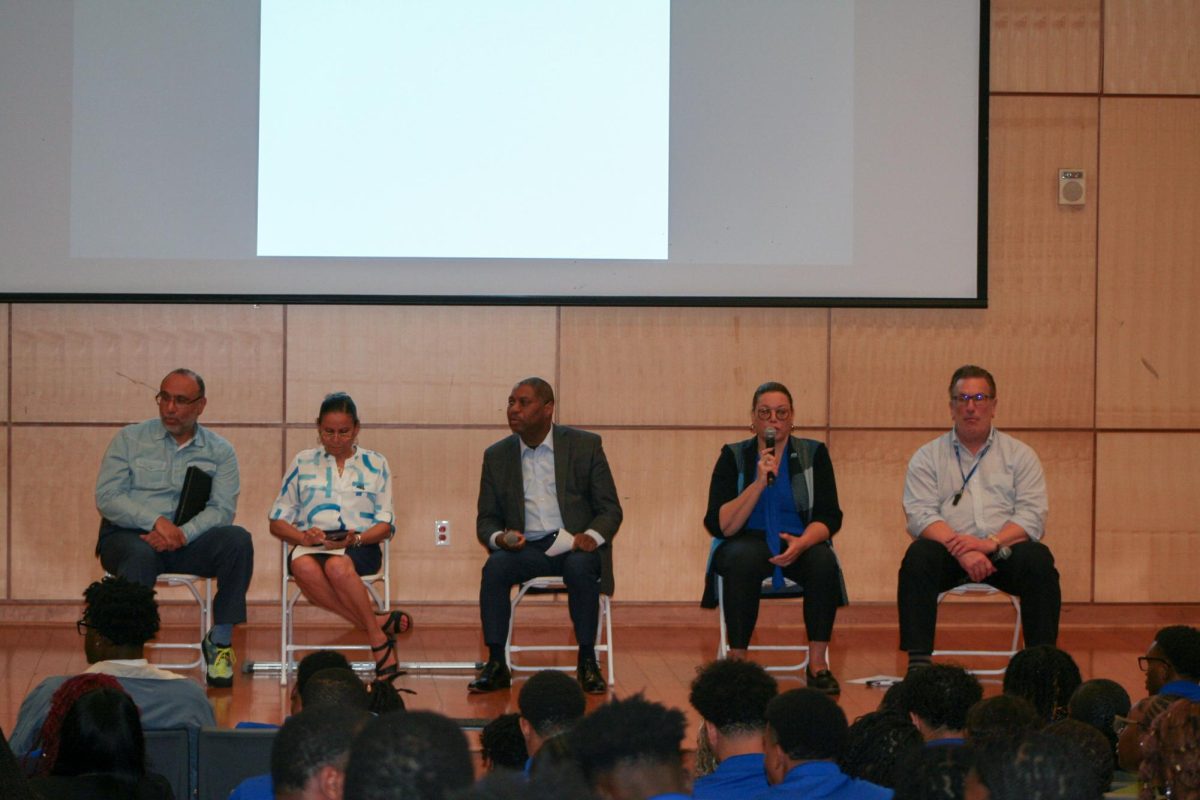On the wall in the foyer of Dillard’s newest building, DUICEF, hang two drums; below them is a huge, brown wheel on the floor. Those passing by or entering get a glimpse of all three structures, but few know the significance of them.
The wheel, entitled, “Ezekiel’s Wheel,” and the drums, “Ezekiel’s Double Drums,” both stem from an idea posed by W.E.B. DuBois in his book, The Souls of Black Folk. “It is the concept of twoness,” said Terry Adkins, the creator and sculptor.
Adkins used this concept – developed from an excerpt in the book about “double consciousness,” – as well as, the ideas of time and earth and celestial movement to create the wheel and the drums. Time is greatly symbolized by the sculpture. It is depicted through days and age. Also, symbolic of time is the union of tradition and innovation. The wheel, which is two wheels put together, has 28 spokes, which mark the 28 days in a lunar cycle. “In that sense, it marks time in heaven,” said Adkins. The wheel marks time, also, on earth when it is compared to a tree. “One can count the rings on a tree to determine its age,” he said.
The artist said it was necessary to bring to life DuBois’ double consciousness concept because it represented the theme Dillard had for the new building. “I needed something that would express Dillard’s history and future paired with DUICEF,” said Adkins. Dubois’ concept seemed perfect to Adkins. In the excerpt, Dubois writes about “two warring ideals”; this is the major theme behind the decision to display these particular structures in the building. “DUICEF is contemporary, yet it is traditional. These combating characteristics are represented by the two wheels placed together as one and the two drums hanging above it,” said Adkins.
The art in the foyer in DUICEF, though rather interesting, has baffled many DU students who had no prior information about the structures.
“I was very confused with the sculpture because it did not appear to have any relevance to the building,” said Adrienne Wiltz, a junior nursing major.
DeTrece Williams, 21, a senior accounting major shared these exact sentiments. “I did not quite understand the purpose of a gigantic wheel or the drums.
The placement of the art was the most confusing. “I wondered why the sculpture was placed in the middle of the foyer. It seemed very distant and not significant, but after I learned the reason of its placement in the new building, I had a greater appreciation for the artwork,” said Williams.
Matthew Barnes, 22, business management major, developed his own opinion of the purpose of the art. “My first thought of the wheels was that they would improve the acoustics,” he said.
There are some, however, who immediately admired the sculptures. “Both structures, the wheel and the drums, are absolutely beautiful,” said Dr. Gloria C. Love, an instructor in computer science.
Contrary to the other buildings on the campus, administrators suggested that DUICEF have artwork. “They wanted it to say something powerful, something that might explain the new direction in which the University was going,” said Adkins.
Because the other facilities do not have sculptures, some people believe that DUICEF makes the rest of the buildings look too old. “Though Dillard is known for having an attractive campus, DUICEF is behind the older buildings, and it appears as though it does not belong,” said Wiltz. “Administration might consider redesigning the other facilities to give them a more modern appeal.”
Many pose suggestions for advancing the other facilities on campus without destroying the art’s purpose.
“If people understand the meaning of the wheel, they might not want to renovate the new building. However, DUICEF does outshine the administration building, Rosenwald, along with Stern, Cook, and Dent,” said Williams. “Perhaps something could be done to maintain the artist’s purpose for the sculptures without upstaging the other facilities
































